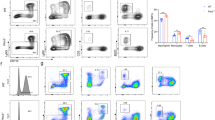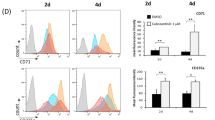Abstract
In response to PMA treatment K562 myelogenous leukemia cells undergo megakaryocytic differentiation, which is dependent on prolonged ERK activation and is characterized by growth arrest, upregulation of CD41 and IL-6, and, finally, by characteristic changes in cell morphology. The tyrosine phosphatase HePTP was recently demonstrated to regulate ERK activity and changes in HePTP expression have been associated with hematopoietic malignancies. Here, we have studied the function of HePTP during PMA-induced megakaryocytic differentiation of K562 cells. Overexpression of HePTP or inhibition of HePTP expression with antisense cDNA had no effect on PMA-induced cell cycle arrest or upregulation of cyclin D in K562 cells. The expression of megakaryocytic markers such as CD41 and IL6, however, were highly reduced in cells overexpressing HePTP, due to reduced ERK activation, and the cells were impaired in their ability to differentiate. Compared to control cells, HePTP antisense expressing cells did not show increased basal or PMA-induced ERK activity. However, antisense inhibition of HePTP enhanced nuclear translocation of ERK and the expression of the megakaryocytic markers CD41 and IL-6. Interestingly, like cells overexpressing HePTP, morphological differentiation was also impaired in HePTP antisense expressing cells. The results for the first time demonstrate that different aspects of megakaryocytic differentiation have distinct requirements for ERK activity. They further show that HePTP is involved in the regulation of nuclear translocation of ERK2 and that HePTP protein levels can modulate K562 cell differentiation.
This is a preview of subscription content, access via your institution
Access options
Subscribe to this journal
Receive 12 print issues and online access
$259.00 per year
only $21.58 per issue
Buy this article
- Purchase on Springer Link
- Instant access to full article PDF
Prices may be subject to local taxes which are calculated during checkout








Similar content being viewed by others
References
Cobb MH, Goldsmith EJ . How MAP kinases are regulated. J Biol Chem 1995; 270: 14843–14846.
Lewis TS, Shapiro PS, Ahn NG . Signal transduction through MAP kinase cascades. Adv Cancer Res 1998; 65: 49–139.
Garrington TP, Johnson GL . Organization and regulation of mitogen-activated protein kinase signaling pathways. Curr Opin Cell Biol 1999; 11: 211–218.
Treisman R . Regulation of transcription by MAP kinase cascades. Curr Opin Cell Biol 1996; 8: 205–215.
Cobb MH, Goldsmith EJ . Dimerization in MAP-kinase signaling. Trends Biol Sci 2000; 25: 7–9.
Whalen AM, Galasinski SC, Shapiro PS, Stines Nahreini T, Ahn NG . Megakaryocytic differentiation induced by constitutive activation of mitogen-activated protein kinase kinase. Mol Cell Biol 1997; 17: 1947–1958.
Racke FK, Lewandowska K, Goueli S, Goldfarb AN . Sustained activation of the extracellular signal-regulated kinase/mitogen-activated protein kinase pathway is required for megakaryocytic differentiation of K562 cells. J Biol Chem 1997; 272: 23366–23370.
Shelly C, Petruzzelli L, Herrera R . PMA-induced phenotypic changes in K562 cells: MAPK-dependent and -independent events. Leukemia 1998; 12: 1951–1961.
Kang C-D, Do I-R, Kim K-W, Ahn B-K, Kim S-H, Chung B-S, Jhun B-H, Yoo M . Role of Ras/ERK-dependent pathway in erythroid differentiation of K562 cells. Exp Mol Med 1999; 31: 76–82.
Keyse SM . Protein phosphatases and the regulation of mitogen-activated protein kinase signaling. Curr Opin Cell Biol 2000; 12: 186–192.
Saxena M, Williams S, Brockdorff J, Gilman J, Mustelin T . Inhibition of T cell signaling by mitogen-activated protein kinase-targeted hematopoietic tyrosine phosphatase (HePTP). J Biol Chem 1999; 274: 11693–11700.
Oh-hora M, Ogata M, Mori Y, Adachi M, Imai K, Kosugi A, Hamaoka T . Direct suppression of TCR-mediated activation of extracellular signal-regulated kinase by leukocyte protein tyrosine phosphatase, a tyrosine-specific phosphatase. J Immunol 1999; 163: 1282–1288.
Pettiford SM, Herbst R . The MAP-kinase ERK2 is a specific substrate of the protein tyrosine phosphatase HePTP. Oncogene 2000; 19: 856–869.
Saxena M, Williams S, Gilman J, Mustelin T . Negative regulation of T cell antigen receptor signal transduction by hematopoietic tyrosine phosphatase (HePTP). J Biol Chem 1998; 273: 15340–15344.
Pulido R, Zu’niga A, Ullrich A . PTP-SL and STEP protein tyrosine phosphatases regulate the activation of the extracellular signal-regulated kinases ERK1 and ERK2 by association through a kinase interaction motif. EMBO J 1998; 17: 7337–7350.
Adachi M, Sekiya M, Isobe M, Kumura Y, Ogita Z-I, Hinoda Y, Imai K, Yachi A . Molecular cloning and chromosomal mapping of a human protein-tyrosine phosphatase LC-PTP. Biochem Biophys Res Commun 1992; 186: 1607–1615.
Zanke B, Suzuki H, Kishihara K, Minden M, Pawson A, Mak TW . Cloning and expression of an inducible lymphoid-specific, protein tyrosine phosphatase (HePTPase). Eur J Immunol 1992; 22: 235–239.
Lombroso PJ, Murdoch G, Lerner M . Molecular characterization of a protein-tyrosine-phosphatase enriched in striatum. Proc Natl Acad Sci USA 1991; 88: 7242–7246.
Hendriks W, Schepens J, Burgman C, Zeeuwen P, Wieringa B . A novel receptor-type protein tyrosine phosphatase with a single catalytic domain is specifically expressed in mouse brain. Biochem J 1995; 305: 499–504.
Zuniga A, Torres J, Ubeda J, Pulido R Interaction of mitogen-activated protein kinases with the kinase interaction motif of the tyrosine phosphatase PTP-SL provides substrate specificity and retains ERK2 in the cytoplasm. J Biol Chem 1999; 274: 21900–21907.
Saxena M, Williams S, Tasken K, Mustelin T . Crosstalk between cAMP-dependent kinase and MAP kinase through a protein tyrosine phosphatase. Nature Cell Biol 1999; 1: 305–311.
Blanco-Aparicio C, Torres J, Pulido R . A novel mechanism of MAP kinase activation and nuclear translocation mediated by PKA and the PTP–SL tyrosine phosphatase. J Cell Biol 1999; 147: 1129–1135.
Lee CH, Yun HJ, Kang HS, Kim HD . ERK/MAPK pathway is required for changes of cyclin D1 and B1 during phorbol 12myristate 13-acetate-induced differentiation of K562 cells. Life 1999; 48: 585–591.
Ku H, Meier KE . Phosphorylation of paxillin via the ERK mitogen-activated protein kinase cascade in EL4 thymoma cells. J Biol Chem 2000; 275: 11333–11340.
Herrera R, Hubbell S, Decker S, Petruzzelli L A role for the MEK/MAPK pathway in PMA-induced cell cycle arrest: modulation of megakaryocytic differentiation of K562 cells. Exp Cell Res 1998; 238: 407–414.
Williams MJ, Du X, Loftus JC, Ginsberg MH . Platelet adhesion receptors. Semin Cell Biol 1995; 6: 305–314.
Navarro S, Mitjavila MT, Katz A, Doly J, Vainchenker W . Expression of interleukin 6 and its specific receptor by untreated and PMA-stimulated human erythroid and megakaryocytic cell lines. Exp Hematol 1991; 19: 11–17.
Xie P, Chan FSL, Ip NY, Leung M-F . Induction of gp130 and LIF by differentiation inducers in human myeloid leukemia K562 cells. Leukemia Res 1999; 23: 1113–1119.
Butler TM, Ziemiecki A, Friis RR . Megakaryocytic differentiation of K562 cells is associated with changes in the cytoskeletal organization and the pattern of chromatographically distinct forms of phosphotyrosyl-specific protein phosphatases. Cancer Res 1990; 50: 6323–6329.
Uchida M, Kirito K, Shimizu R, Miura Y, Ozawa K, Komatsu N . A functional role of mitogen-activated protein kinases, erk1 and erk2, in the differentiation of a human leukemia cell line, UT-7/GM: a possible key factor for cell fate determination towards erythroid and megakaryocytic lineages. Int J Hematol 2001; 73: 78–83.
Witt O, Sand K, Pekrun A . Butyrate-induced erythroid differentiation of human K562 leukemia cells involves inhibition of ERK and activation of p38 MAP kinase pathways. Blood 2000; 95: 2391–2396.
Miyazaki R, Ogata H, Kobayashi Y . Requirement of thrombopoietin-induced activation of ERK for megakaryocyte differentiation and of p38 for erythroid differentiation. Ann Hematol 2001; 80: 284–291.
Woessmann W, Mivechi NF . Role of ERK activation in growth and erythroid differentiation of K562 cells. Exp Cell Res 2002; 264: 193–200.
Rivero JA, Adunyan SE . Sodium butyrate induces tyrosine phosphorylation and activation of MAP kinase (ERK-1) in human K562 cells. Biochem Biophys Res Commun 1996; 224: 796–801.
Gronda M, Arab S, Iafrate B, Suzuki H, Zanke BW . Hematopoietic protein tyrosine phosphatase suppresses extracellular stimulus-regulated kinase activation. Mol Cell Biol 2001; 21: 6851–6858.
Cheng A, Bal GS, Kennedy BP, Tremblay ML Attenuation of adhesion-dependent signaling and cell spreading in transformed fibroblast lacking protein tyrosine phosphatase-1B. J Biol Chem 2001; 276: 25848–25855.
Zanke B, Squire J, Griesser H, Henry M, Suzuki H, Patterson B, Minden M, Mak TW . A hematopoietic protein tyrosine phosphatase (HePTP) gene that is amplified and overexpressed in myeloid malignancies maps to chromosome 1q32.1. Leukemia 1994; 8: 236–244.
Mitelman F, Kaneko Y, Trent J . Report of the committee on chromosome changes in neoplasia. Cytogenet Cell Genet 1990; 55: 358–386.
Acknowledgements
We would like to thank Emma Lees, Jim Johnston, Jing Wang, Scott Frank, and David Parry for helpful suggestions and critically reading the manuscript. We thank Jing Wang for her assistance with the cell cycle analysis. We also thank Gary Burget and Maribel Andonian for graphics support. DNAX Research Institute is fully supported by Schering-Plough Corporation.
Author information
Authors and Affiliations
Rights and permissions
About this article
Cite this article
Pettiford, S., Herbst, R. The protein tyrosine phosphatase HePTP regulates nuclear translocation of ERK2 and can modulate megakaryocytic differentiation of K562 cells. Leukemia 17, 366–378 (2003). https://doi.org/10.1038/sj.leu.2402767
Received:
Accepted:
Published:
Issue Date:
DOI: https://doi.org/10.1038/sj.leu.2402767



